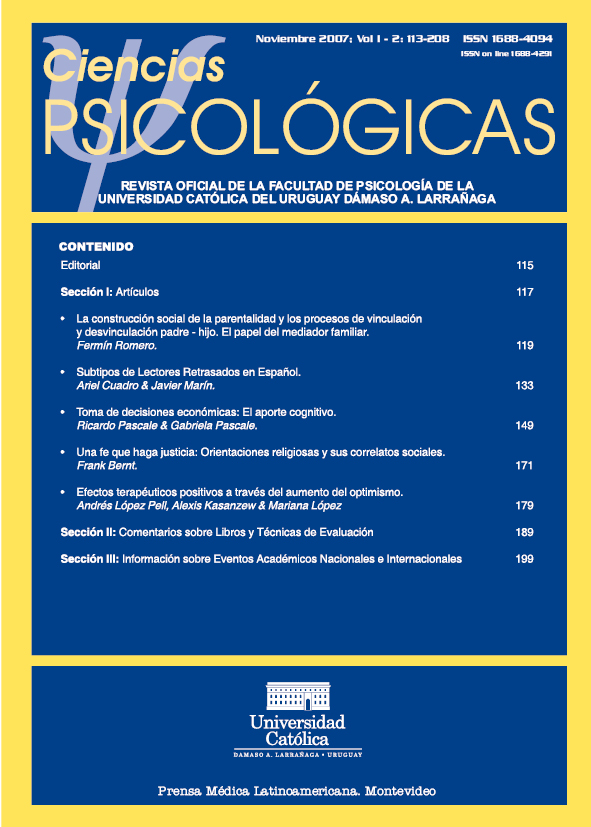SUBTYPES OF SUBJECTS WITH READING DISABILITIES IN THE SPANISH LANGUAGE
DOI:
https://doi.org/10.22235/cp.v0i1.545Keywords:
reading, reading disability, dyslexia, assessmentAbstract
With the purpose of identifying and demonstrating the characteristics of dyslexic subtypes in the Spanish language (phonological and superficial dyslexics), 42 subjects with reading disabilities were assessed in the 4th, 5th, and 6th elementary grades as well as 90 subjects with normal reading ability in the same grades and 78 subjects with normal reading ability on a lower elementary grade but equivalent reading ability. Group performance was analyzed in tasks that involved phonological and orthographic processing. Using a regression analysis methodology we find some variations in the distribution of the subtypes of subjects with reading disabilities. The idea that the types of phonological and superficial dyslexia are different in severity degree in the phonological disorder and the cognitive resources available to compensate for it is applied (Snowling, 2000). The transparency of the language, as well as the reading experience, favors the learning of the grapheme-phoneme rule, improving the reading accuracy of non-words.Downloads
References
Aaron P.G., Ayotolah M., Ellsberry A., Henderson J. y Lindsey K. (1999). Decoding an sight-word naming: Are they independent component of word recognition skill?. Reading an Writing: An Interdisciplinary Journal, 11:89-127.
Algarabel, S.(1996) Índices de interés psicolingüístico de 1.917 palabras castellanas.
Cognitiva, 8 (1), 43-88.
Asensio, M., (1989). Los Procesos De Lectura De Los Deficientes Auditivos. Tesis de doctorado.
Universidad Autónoma de Madrid.
Bailey, C., Manis, F., Pedersen, W. y Seidenberg, M. (2004). Variation among developmental dyslexics: Evidence from a printed-word-learning task. Journal of Experimental Child Psychology. 87:125-154.
Calvo, A. (1999). Adquisición de la lectura en lengua castellana: perfiles cognitivos de aprendices
con dificultades. Tesis de doctorado. Universidad de Murcia.
Carrillo, M., Marín, J. y Calvo, A. (1999). Distribución de subtipo de dislexia durante el desarrollo de la habilidad lectora. IV Simposio de Picolingüística. Madrid. 21 – 24 Abril.
Castles, A. & Coltheart,M. (1993). Varieties of developmental dyslexia. Cognition, 47(2),149-180.
Cattell, R.B. y Cattell, A.K.S. (1950). Handbook for the individual or Group Culture Fair (or Free) Intelligence Test (a measure of “g”). Scale 1. Illinois: Institute for Personality an Ability Testing. Publicado en castellano por TEA S.A. Madrid (1994).
Cuadro, A. (2006). Caracterización de los malos lectores en relación a los buenos lectores en niños uruguayos. Tesis doctoral. Universidad de Murcia. España.
Cuetos, F., Rodríguez, B., y Ruano, E. (1998). PROLEC. Batería de Evaluación de los Procesos
Lectores de los Niños de Educación Primaria. Madrid: TEA.
Domínguez, A., De Vega, M. & Cuetos,, F. (1997). Lexical inhibition from syllabic units in Spanish visual Word recognition. Language and Cognitive Processes, 12(4),401-422.
Frith, U.(1985) Beneath the surface of developmental dyslexia. En K.E. Patterson, J.C. Marshall y M. Coltheart (Eds.) Surface dyslexia: Neuropsychological and cognitive studies of phonological reading (pp.310-330) Hillsdale, NJ.
Lawrence Erlbaum Associates. Genard (2000) La dyslexie du développement: étude de son caractère unique ou multiple de son étiologieà l’aide d’une approche comparative et logitudinale. Tesis Doctoral. Universidad Libre de Brusselas.
Jiménez, J. E., Álvarez, C., Estévez, A. y Hernández I. (1998). Onset-Rime units in visual word
recognition in normal Spanish readers and reading disabled children. Papers presented to I.A.R.L.D. Padua.
Manis, F. R., Seidenberg, M.S., Doi, L.,S., McBride- Chang, C. & Petersen, A. (1996). On the bases
of two subtypes of development dyslexia. Cognition, 58, 157-195.
Manis, F. R., Seidenberg, M, & Doi, L., (1999). Rapid naming and the longitudinal prediction of reading sub-skills in first and second graders. Scientific Studies of reading, 3, 129-157.
Marín, J. y Carrillo, M. S. (1999) Test Colectivo de Eficacia Lectora (TECLE). Manuscrito no publicado. Departamento de Psicología Básica y Metodología. Universidad de Murcia.
Marín, J., Aveledo, F., Vera, F. y Alegría, J. (2004). El papel de la fonología en la adquisición del léxico ortográfico. El caso de los grafemas “g” y “c”. Comunicación presentada al V Congreso de la
Sociedad Española de Psicología Experimental(SEPEX) Madrid.
Morais, J. (1998). El Arte De Leer, Madrid, Visor.
Porpodas, C. (1999) Patterns of phonological and memory processing in beginning readers and
spellers of Greek. Journal of Learning Disabilities. Vol 32, Issue 5, 384.
Santos, A. (1996). Intervención En Dificultades En Lectoescritura Para 2° De Educación Primaria. En servicio municipal de atención psicológica y educativa: Memoria De Actividades, 1994/95, Patronato Municipal De Servicios/Ayuntamiento De San Sebastián De Los Reyes (Madrid).
Seymour, P.H.K. & MacGrecor, C. J.(1984). Developmental dyslexia: a cognitive experimental analysis of phonological, morphemic and visual impairments. Cognitive Neuropsychology, 1,43-83.
Seymour, P.H.K., & Evans, H. M. (1993). The visual (orthographic) processor and developmental dyslexia. In D.M. Willows, R.S. Kruk, & E. Crocos (Eds), Visual processes in reading and reading
disabilities (pp.347-376). Hillsdale, New Jersey:LEA, Hove and London.
Share, D. L. (1995) Phonological recoding and selfteaching: sine qua non of reading acquisition. Cognition, 55, 515-218.
Share, D. L. (1999). Phonological recoding and orthographic learning: A direct test of the selfteaching
hypothesis. Journal of Experimental Child Psychology 72, 95 129.
Share, D. L.; Stanovich, K. (1995) Cognitive processes in early reading development; Accommodating individual differences into a model of acquisition. Issues in Education, 1, 1-57.
Snowling, M. J. (1998).Dyslexia. Oxford. England: Blackwell.
Snowling, M. J., Goulandris, N., & Defty, N. (1998). Development and variation in developmental dyslexia. In C. Hulme & J.R. Malatesha (Eds.) Reading and spelling: Development and disorders
(pp. 201-217). Mahwah, NJ, USA: Lawrence Erlbaum Associates.
Stanovich, K. E., Siegel, L. S., & Gottardo, A. (1997). Converging evidence for phonological and surface subtypes of reading disability. Journal of Educational Psychology, 89(1), 114-127.
Wimmer H. (1993). Characteristics of developmental dyslexia in a regular writing system. Applied
Psycholinguistics,14 1-33.
Wimmer, H. (1996b) The non-word reading deficit in developmental dyslexia: Evidence from
children learning to read German. Journal of Experimental Child Psychology, 61, 80-90.
Wolf, M., & Bowers, P. G. (1999). The double-deficit hypothesis for the developmental dyslexias. Journal of Educational Psychology, 91(3), 415-438.
Downloads
Published
How to Cite
Issue
Section
License
Copyright (c) 2007 Universidad Católica del Uruguay

This work is licensed under a Creative Commons Attribution 4.0 International License.
















